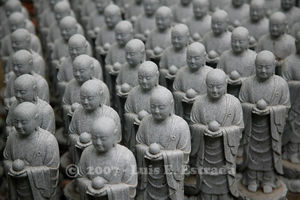Advertisement

 Small Buddhas at Hasedera
Small Buddhas at Hasedera
Every statue representing a dead child (mainly to abortion or miscarriage) After a busy business week in Tokyo, my German colleagues, Andreas Luengen, Volkmar Tietz and I decided to spend Saturday in the town of Kamakura. Neither Andreas nor Volkmar had ever been in Japan before, so I considered it my responsibility to show them around…. For me, it was probably the third or fourth visit to Kamakura, but this time, I wanted to see any places or have any experiences that I missed during previous trips there.
One of my old guidebooks recommended taking the Odakyu Line from Shinjuku to the town of Fujisawa, and from there, taking the old electric tram with the official name of Eno-Den Line through picturesque neighborhoods and along the coast line into the Hasen Station in Kamakura. Hasen Station is the closest one to Daibutsu, the Great Buddha, which is one of the main attractions in town.
Since Volkmar and Andreas are staying at a hotel in Hakozaki, we agreed the day before that they were going to come to my hotel in Shinjuku and from there we would depart together for Kamakura. They arrived about 10 minutes past 8:00 AM and together we took the hotel’s shuttle bus to Shinjuku Station.
The shuttle actually left us in a place very close to the Odakyu train tracks within Shinjuku, so we proceeded to pay the 570-yen fare and got to the track where we boarded an “express” train to our destination. We quickly discovered that “express” train only meant that we were bypassing a small number of stations along the way. We still stopped at plenty of stations and it took us over one hour to get to Fujisawa.
As we arrived at the Eno-Den Line tracks, we waited with many locals and anticipated the arrival of the old tram that according to my guidebook exuded character… When the train finally arrived, the big surprise was that it did not look any different from the other local trains that you see all over Japan. I was somewhat disappointed to not be able to experience this legacy of history. As we were departing the station on board the run-of-the-mill train, Andreas located an old picture at the station that depicted the old tram. We were still hopping that perhaps there were still some old trains running, but perhaps they just did it at certain hours of the day. After this experience with
the Eno-Den Line, I should have been a bit more skeptical about what my guidebook recommended, but another big disappointment was in store for us later in the day.
We got off at the Hasen station and started to walk in the direction of Daibutsu. A few blocks later, we ran upon the entrance to the Hasedera Shrine where many other tourists, foreign and local, were about to go in. The entrance to the temple was being overrun with photographers of all types, many of them using very impressive pieces of photographic equipment. I joined the melee of cameras and shooters and proceeded to capture my first images of the day… Andreas followed suit.
As we captured all the images that we wanted to capture there, we proceeded to pay the 300-yen entrance fee and went inside the shrine. The place was very busy, but it was still very enjoyable and even felt peaceful in spite of the crowds everywhere. As we explored the first area of gardens, I discovered that the place was full of flowers and realized that the last time I visited Kamakura, it was possibly around winter time and the colorful displays were simply
not there.
When we climbed to the main level of the shrine, we discovered that there was a zigzagging line to visit the upper areas of the complex; you could only get in line according to your entry ticket number. Andreas, Volkmar and I joined the line and started the slow process up.
It was not until we reached the base of the path behind one of the main temple structures that we realized the reason for so much interest from the locals: The gardens covering the small but steep mountain behind the temple was completely covered with blossoming hydrangeas of all colors and varieties. The locals were out in force enjoying the view and capturing video and photos of the plants (and themselves among the flowers). We were lucky to visit Kamakura at the peek of hydrangea-blooming season.
We completed the circuit up and down the little mountain garden and returned to an area on the main level of the temple that commands a great view of the town and the Pacific Ocean beyond. In this area of the temple there are several tables and chairs so that visitors can enjoy the view and consume refreshments
conveniently sold by vending machines nearby. The area was full of people, but Volkmar, Andreas and I noticed a magnificent hawk gliding the air currents just above the trees around our immediate area. I snapped some pictures of the bird but due to the bright overcast sky above, it was difficult to adjust the camera’s exposure to get some detail of its plumage. I had to content myself to get a silhouetted view of the bird during its quick passes above us.
At one point, while I was distracted speaking with Volkmar, the bird did something sudden and unexpected: out of the corner of my eye, I saw a quick shadow heading straight for us, Volkmar and I ducked our heads and the bird passed within six feet of us and almost landed on a table surrounded by other visitors behind us. They got scared and scrambled away from the table as fast as they could, but the bird just flew over and started to ascend to a level above the trees once again. I was so disappointed that I did not keep my eye (and my camera) on the bird during this sudden approach. Andreas, who witnessed the
entire incident, tried to snap a picture at the closest point of the approach, but his small camera failed to take the picture when he pressed the shutter button, so he missed the opportunity for a great shot too.
We left Hasedera Temple and resumed our way towards Daibutsu, just a couple of blocks away. As with other attractions in Japan, there was a small fee of 200 yen to gain entry into the complex. The big Buddha was there just as I remember it and Andreas and Volkmar appeared to be enjoying the site. I spent some time trying to find new angles from where to photograph the big Buddha… From my previous visit, I had probably taken pictures from about everywhere accessible to a human being. A crow flying around and sitting on the head of the statue made me wish that I could mount my camera on some sort of aerial device to take pictures from that particular bird’s view.
We did not spend too much time at Daibutsu and started to walk towards another shrine recommended by my guidebook: the 1,200-year-old Amanawa-Shinmeisha. This particular temple was up on another small mountain or very steep
hill overlooking Kamakura and was supposed to have the best view of the town and the ocean beyond. The maps that we were using were provided at the entrance of Hasedera and had the double function of being hand fans to keep cool in the hot and humid weather of Kamakura in the summer. Unfortunately, as maps go, they were not very accurate, and we had to ask directions from the locals at least three times before we found the approach street towards the shrine's entrance.
From the bottom of the stairway to Amanawa-Shinmeisha shrine, the place looked closed, so I volunteered to go up to check it out before asking Andreas and Volkmar to go up too. Volkmar was having trouble with his knees and did not need to make unnecessary physical efforts.
When I got to the main level of the shrine, I verified that the building itself was closed, though that fact did not prevent the single other visitor there to pay his respects to the shrine’s deities. I verified that there was another path heading up to another structure at a higher level. After calling Volkmar and Andreas to join me, we together climbed
beyond the first building and discovered a small Tori gate over a path heading up the mountain.
Driven by the desire to get to the point with the “majestic view” described in my guide book, we continued upwards without getting too concerned that the quality of the path had started to deteriorate very rapidly into a very strenuous, narrow, and dangerous path with many trees and tree roots that made our march quite slow and difficult. I felt guilty to drag Volkmar uphill with us, since I knew he was having a hard time with his knees. But he was a good sport and did not utter a word in protest for the abuse…
After the long climb, we finally reached the top of the small mountain but the place was so overgrown with grasses, shrubs and trees of every size, that it was impossible to see beyond the jungle around us or even walk without having a machete to clear the path… No great view whatsoever after all the effort getting there! We retraced our steps down and decided to not pay any attention to my guidebook anymore.
Our next destination was the beach area, where
we hoped to find a watering hole to have some well-deserved beers in the fine German tradition. Distances in Kamakura are not very long to have to rely on trains, taxis, or buses, so we walked from Amanawa-Shinmeisha, in the general direction of the Japan Rail (JR) Kamakura Station.
When we got closer to Kamakura Station, we turned right and followed a major thoroughfare towards the ocean (and the beach). We got there in due time, but aside from a major road that ran parallel to the coast and a few beachgoers and surfers at the beach proper, there were no establishments (that we could see) to satisfy our thirst for a beer. We did enjoy the ocean breeze for a while though and noticed that even there, we could still see several hawks fighting among themselves for what one of them had caught.
After a short while we started our walk back to Kamakura Station, which at that point seemed to offer better possibilities to find what we were looking for. We found a café-bar right in front of the station where we were finally able to sit down and enjoy the beers.
The return to
Tokyo via JR was uneventful. I left Andreas and Volkmar when our train reached Shinagawa Station. They continued on the same train to Tokyo Station and I changed to the Yamanote Line to head for my base in Shinjuku.
Advertisement
Tot: 0.062s; Tpl: 0.02s; cc: 8; qc: 24; dbt: 0.0328s; 1; m:domysql w:travelblog (10.17.0.13); sld: 1;
; mem: 1.1mb




















Joaquin Estrada
non-member comment
Hydrangea Season
Great find, Pops!